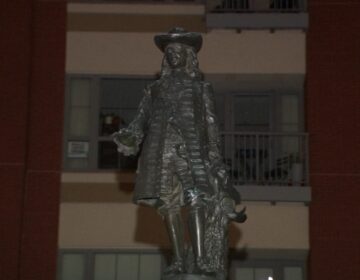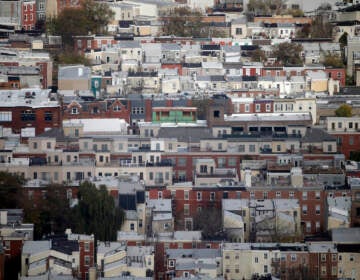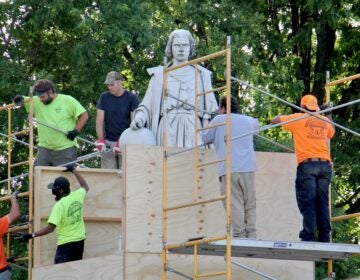Monuments to America’s racist past don’t belong in our public parks
The Philadelphia Art Commission’s decision on Marconi’s Christopher Columbus statue will influence how our city heals from injustices.
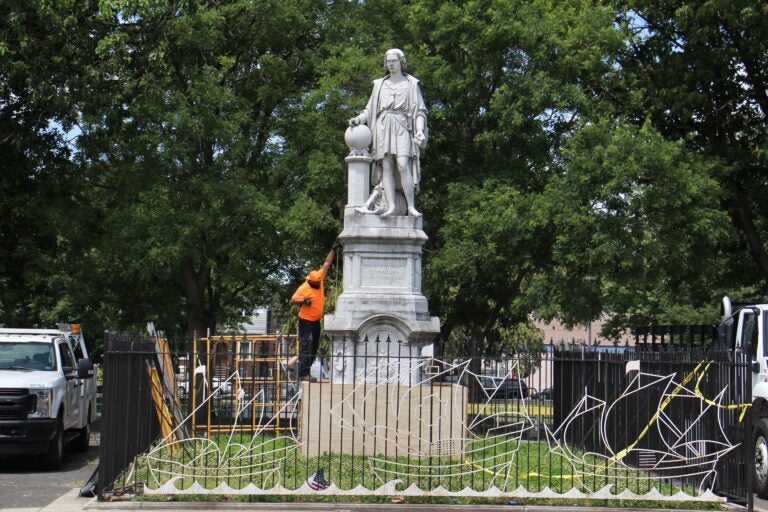
A worker measures the Christopher Columbus statue at Marconi Plaza in South Philadelphia in June 2020. (Emma Lee/WHYY)
We have entered an ideological war and public spaces are the battleground.
On one side is the Black Lives Matter Movement, protesters of criminal injustice and those who believe that the destruction or removal of the symbols of white supremacy — confederate soldiers, generals, leaders and beyond — can begin the process of healing and change in a nation where hypocrisy is embedded in the very fabric of society.
On the other side are those who are vociferous in asserting their right to revere historical figures that hold meaning and believe that tearing down statues dishonors the past, ruptures the present and sets the wrong tone for the future.
It would be easy to assert that on this side of the equation are redneck diehard white supremacists who are vehemently opposed to all things that the Black Lives Matter movement stands for.
That would only be partially true.
Many Italian Americans are horrified at the depiction of Christopher Columbus as a homicidal explorer bent on rape, pillage and destruction. They see him as the discoverer of the “New World,” an important historical figure, and are proud to share his heritage. Yet the Indigenous people of America see his life, explorations and history as an affront to their people, culture and humanity.
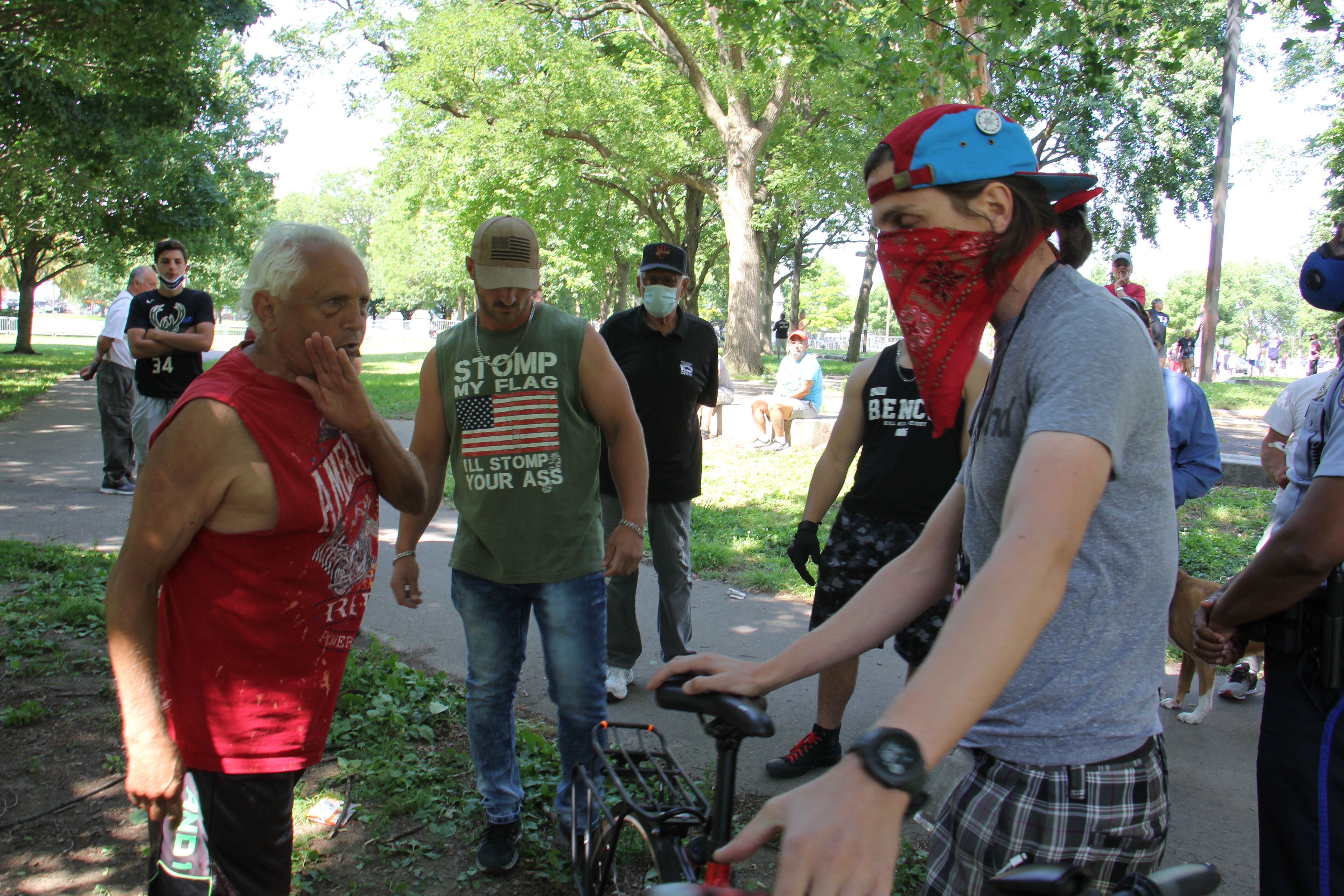
In South Philadelphia, a statue of the explorer stood at the center of protests at Marconi Plaza, stoking a heated public discussion of monuments, history and racism. After a multiday standoff between police and protesters that ended with a Philadelphia Police Department captain reassigned amid concerns that he had not properly managed crowds of pro-Columbus demonstrators, Mayor Kenney asked the city’s Art Commission to approve his administration’s proposal to remove the statue.
This comes after a controversial Frank Rizzo statue in Center City was boxed up and a mural honoring the former mayor painted over in South Philadelphia.
The Philadelphia Art Commission on Wednesday will hold a virtual hearing on the Marconi Columbus and decide whether the controversial statue will, like the Rizzo monument, lose its public perch.
Columbus is one prominent example of how America cherrypicks its history, he is far from the only figure elevated by a whitewashed telling of history.
Those who revere the Founding Fathers and past presidents cite their accomplishments while tending to discount others facts of their lives — such as Thomas Jefferson’s relationship with Sally Hemings, the enslaved woman who gave birth to six of his children after he raped her when she was a teenager.
They would agree with the section of President Donald Trump’s executive order to protect historical American monuments which reads: “These statues are not ours alone, to be discarded at the whim of those inflamed by fashionable political passions; they belong to generations that have come before us and to generations yet unborn. My Administration will not abide an assault on our collective national memory. In the face of such acts of destruction, it is our responsibility as Americans to stand strong against this violence, and to peacefully transmit our great national story to future generations through newly commissioned monuments to American heroes.”
But what is the story that will be told to future generations? What is the narrative that accurately depicts the history of America? What do these statues really mean?
The Supreme Court has already determined that a statue in a city park is speech. In Pleasant Grove City v. Summum, the Supreme Court held that a city government was entitled to select the monuments it displayed in a public park.
Justice Alito’s majority opinion read: “A monument, by definition, is a structure that is designed as a means of expression. When a government entity arranges for the construction of a monument, it does so because it wishes to convey some thought or instill some feeling in those who see the structure.”
What is the feeling that is instilled years later when people of color look at statues that are symbols of white supremacy?
The very fact that city governments are taking down historical statues and monuments that reflect a racist past represents a seismic shift in thinking.
There were 700 Confederate statues spread across 31 states in public spaces before this current dismantling began. Monuments are created to instill values and commemorate events that are vitally important. Most of the confederate statues erected were built between the 1890s and the 1950s with the majority constructed between 1900 and the 1920s. This was a time period when Jim Crow, segregation, the Black Codes, and the lynching of Black men and women were rampant. It was important to the dominant society to glorify the Confederate past and install symbols to exult days which could never be recovered.
This is why the Confederate statues are so offensive to many people. It is why the statues of Columbus are so despised by Indigenous people and all those who recognize the symbolism behind the history. It is why statues of the Founding Fathers leave a sour taste in the mouths of those who understand the reality of America, and the hypocritical words of the Constitution and Bill of Rights built upon the lashed backs and torn muscles of slave labor.

Subscribe to PlanPhilly
Now, however, the nation is poised on the run-up to an election which may be the most divisive in the nation’s history. The events following the death of George Floyd, the dismantling of symbols of racism, the tearing down of statues that elicit such strong emotions, threaten to further divide a nation already at odds with itself.
It is important to realize that the removal of offensive historical symbols is a critical step in the acknowledgment of the massive wrongs that were done to an enslaved people. This act may never change or impact the hearts and minds of people who oppose the very ideas expressed. But it is necessary and vital.
It is possible that the events now occurring may push white people to the point where on Nov. 3, in the sanctity of the voting booth, they push the button for regression, for a return to the normalcy of not having to account for the past. That is what certain elements are hoping for, that people will vote their race and not their conscience. That they will vote for a return to an idyllic past where protests and radical change are not even considered. This is what all the coded messages and commercials intended to terrify the masses are about.
Anarchy and the destruction of public safety are not the end result of the removal of racist imagery. It is the beginning of a better day for all of us, a time where communication can begin. A time where understanding can replace hatred and dialogue can replace rhetoric. I am not a person who believes in some utopian change that will sweep down and transform our society. But I am a believer in putting in the day-to-day work that leads to a transformative society.
Taking down the statues is an essential part of that work.
Jondhi Harrell is a local community activist, returning citizen and executive director of the TCRC Community Healing Center in North Philadelphia.
WHYY is your source for fact-based, in-depth journalism and information. As a nonprofit organization, we rely on financial support from readers like you. Please give today.






